Specific Focus Area Two survey questions
On this page I tēnei whārangi
Can you provide examples of requirements that are too detailed, strict, or inflexible to allow you to comply?
Of the 225 respondents that answered this question:
- Many noted that there was no problem.
- Of those who identified particular requirements, some noted the following as areas of concern:
- The Health and Safety at Work (Hazardous Substances) Regulations 2017.
- Issues contained within Part 2 of the Health and Safety at Work Act.
- A few noted:
- The general complexity of regulations and requirements.
- Approved Codes of Practice and guidance.
- Part 3 of the Health and Safety at Work Act, which covers worker engagement, participation, and representation.
- Other Acts or Regulations than those of the Health and Safety at Work Act.
- Or that the requirements are generally overly burdensome.
Table 12. Requirements that are too detailed, strict, or inflexible to allow you to comply?
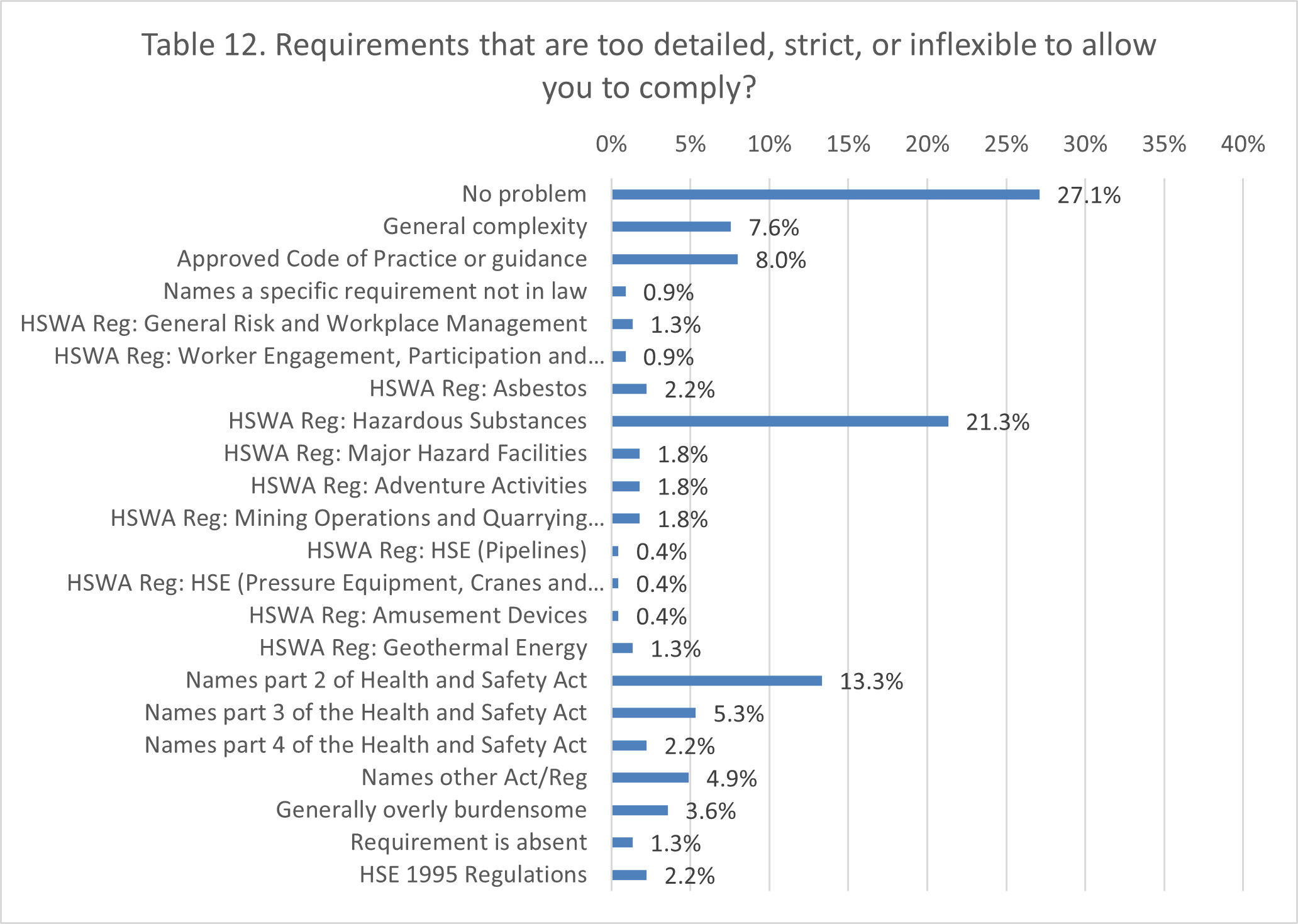
Data from chart
Where there is not enough detail or too much ambiguity in law or regulations to help you comply?
Of the 252 respondents that answered this question, of those identifying particular areas of concern:
- Many noted Approved Codes of Practice and Guidance.
- Some noted that there was no problem, or identified the following areas:
- General complexity of requirements.
- The Health and Safety at Work (Hazardous Substances) Regulations 2017.
- Part 2 of the Health and Safety at Work Act.
- A few noted:
- A requirement that is not actually in law.
- The Health and Safety at Work (General Risk and Workplace Management) Regulations 2016.
- Part 3 of the Health and Safety at Work Act.
- Other Acts or Regulations than those of the Health and Safety at Work Act.
- A requirement that they consider is needed but is not currently provided for in law.
- Health and Safety in Employment Regulations 1995.
Table 13. Where there is not enough detail or too much ambiguity in law or regulations to help you comply?
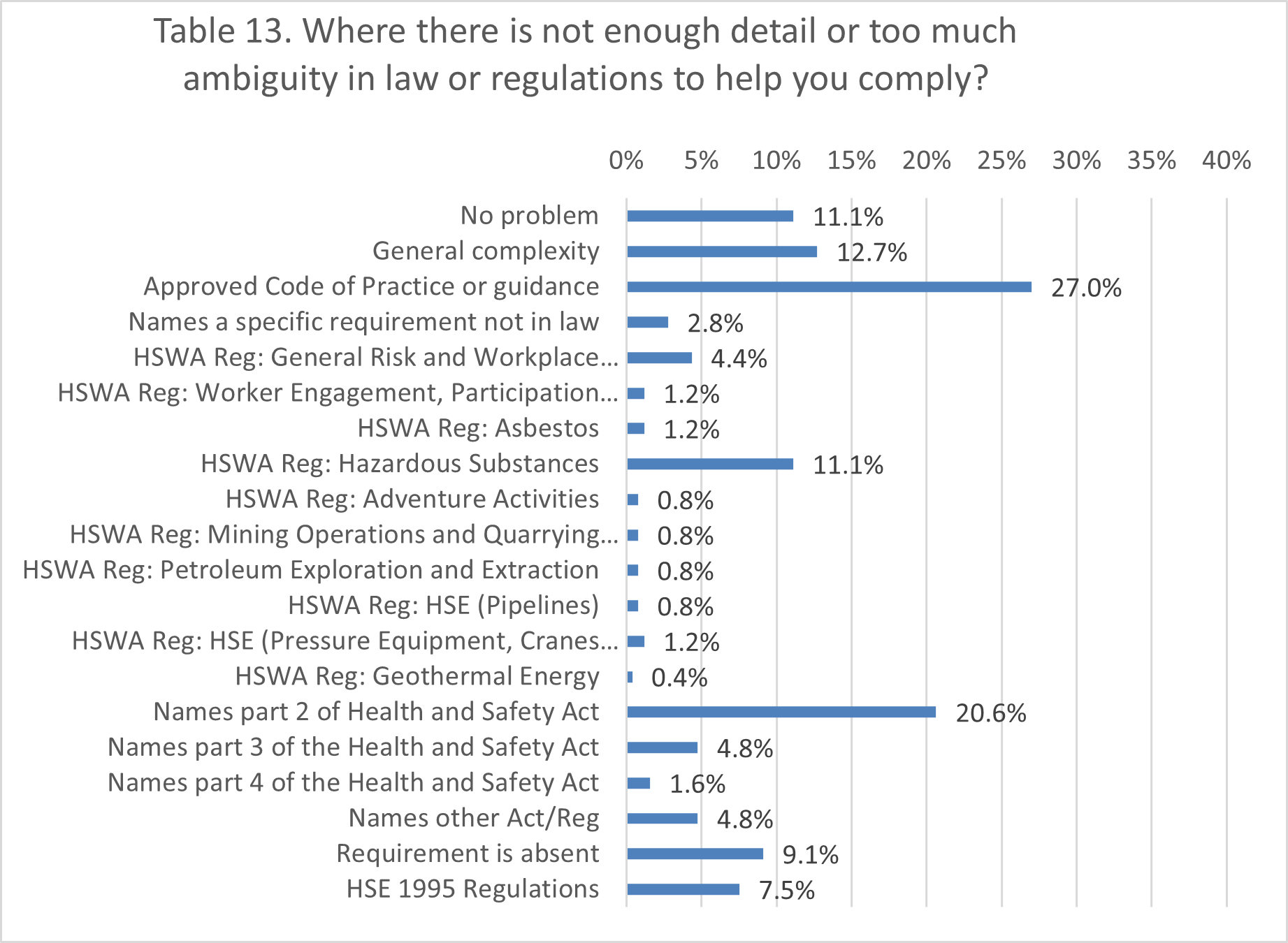
Data from chart
Requirements that are causing you problems?
Of the 225 respondents that answered this question:
- Some responders noted that there was no specific problem with the Act in general, or at all, with others noting the following areas are causing them problems:
- The general complexity of the Act and its Regulations.
- Approved Codes of Practice or Guidance.
- The Health and Safety at Work (General Risk and Workplace Management) Regulations 2016.
- A requirement that they consider is needed but is not currently provided for in law.
- The Health and Safety at Work (General Risk and Workplace Management) Regulations 2016.
- The Health and Safety at Work (Hazardous Substances) Regulations 2017.
- Part 2 of the Health and Safety at Work Act.
- Part 3 of the Health and Safety at Work Act.
- Other Acts or Regulations than those of the Health and Safety at Work Act.
- Health and Safety in Employment Regulations 1995.
- Part 4 of the Health and Safety at Work Act.
Table 14. Requirements that are causing you problems?
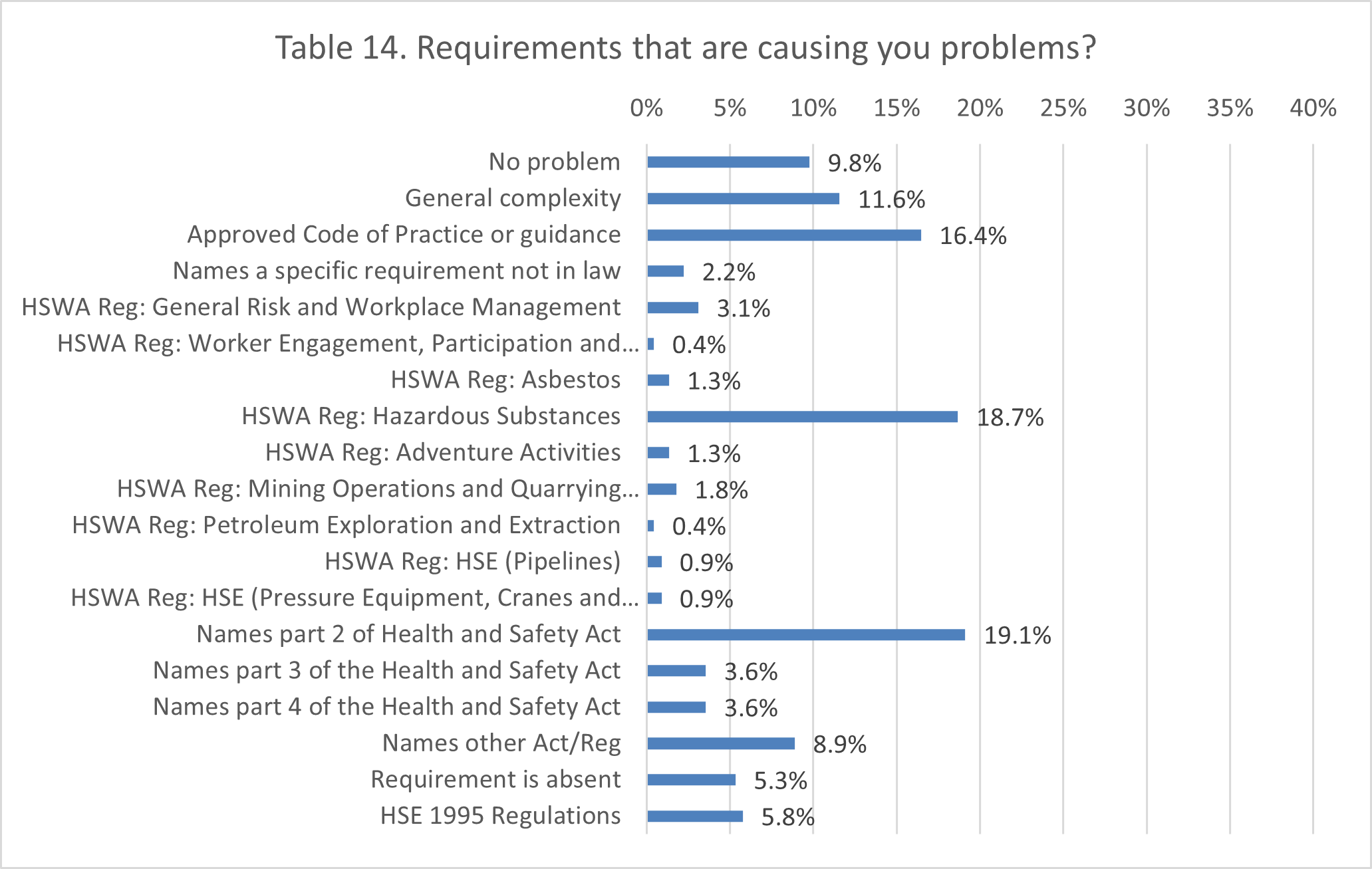
Data from chart
Requirements that are working well?
Of the 175 respondents that answered this question:
- Many responders considered that the Act was working well, and that Part 2 of the Act was working well.
- Few responders considered that the following areas were working well:
- Approved Codes of Practice and Guidance.
- The Health and Safety at Work (General Risk and Workplace Management) Regulations 2016.
- The Health and Safety at Work (Hazardous Substances) Regulations 2017.
- Health and Safety at Work (Major Hazard Facilities) Regulations 2016.
- Part 3 of the Health and Safety at Work Act.
- Other Acts or Regulations than those of the Health and Safety at Work Act.
Table 15. Requirements that are working well?
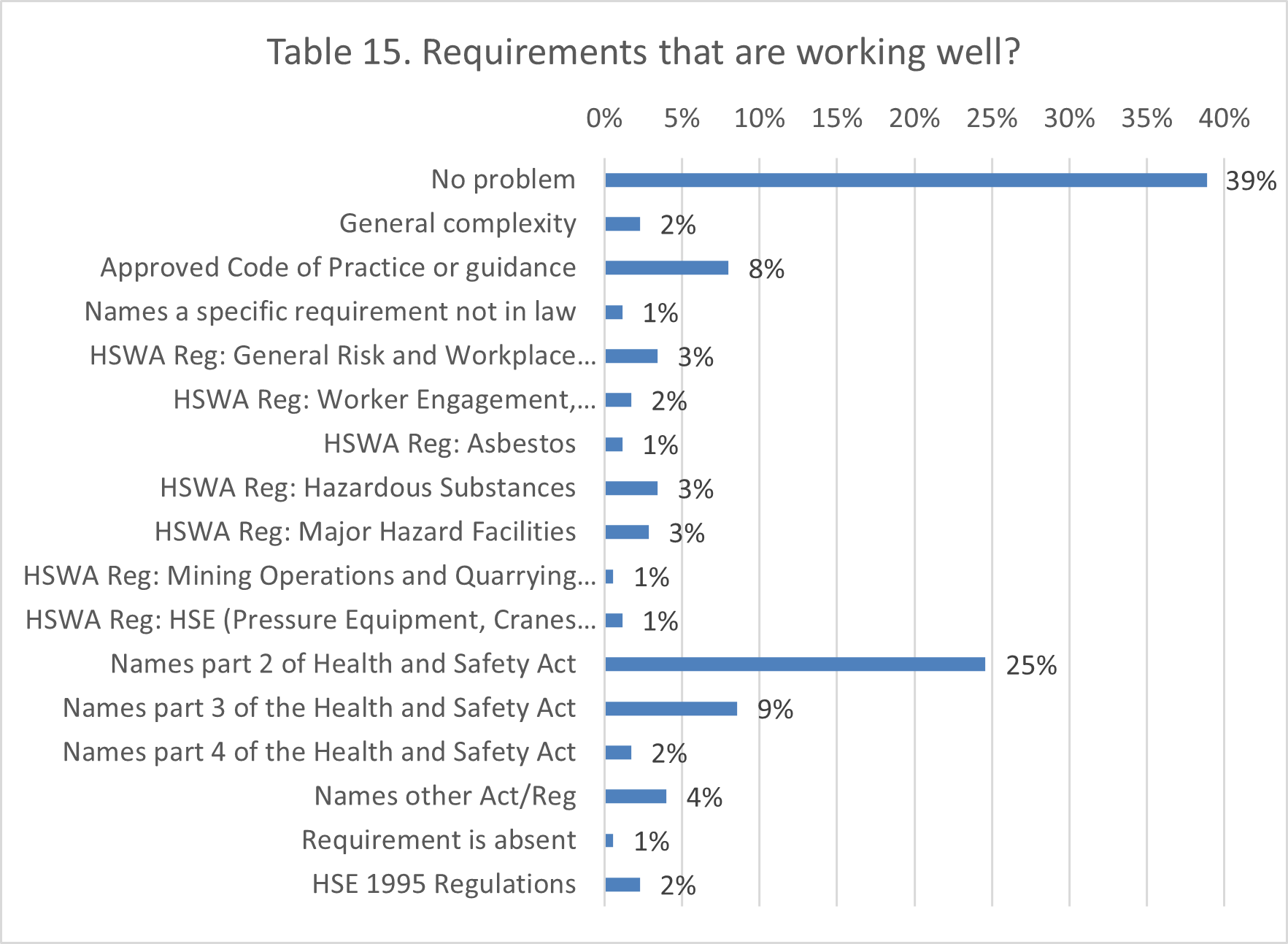
Data from chart
What sources of information or advice do you use to help you understand your responsibilities under the law and how to comply?
Respondents were asked to select all the sources of information they used. Of the 251 respondents that replied:
- Most used laws and regulations, published guidance, approved codes of practice, work health and safety advisors or consultants, the Regulator, third parties and industry associations.
- Some used word of mouth.
- Few used social media or other sources of information.
In relation to the 185 respondents who reported that they used laws and regulations:
- Most considered that they provide clarity about roles and responsibilities, necessary actions, relevance and are easy to find.
- Many considered that these are consistent and easy to apply.
In relation to the 156 respondents who reported that they used Guidance:
- Most considered that these provide clarity about roles, responsibilities and necessary actions, relevance, are easy to find and easy to understand.
- Many considered that these are consistent and easy to apply.
In relation to the 143 respondents who reported that they used Approved Codes of Practice:
- Most considered that these provide clarity about roles and responsibilities, necessary actions, relevance and is easy to find, and are easy to understand.
- Many considered that these are consistent and easy to apply.
In relation to the 114 respondents who reported that they used work health and safety advisors and consultants:
- Most considered that they provide clarity about roles and responsibilities, necessary actions, relevance and are easy to find, and are easy to understand.
- Many considered they are consistent and easy to apply.
In relation to the 126 respondents who reported that they used work health and safety advisors and consultants:
- Most considered that they provide clarity about roles and responsibilities, necessary actions, relevance and are easy to find, and easy to understand.
- Many considered that they are consistent and easy to apply.
In relation to the 83 respondents who reported that they used third parties authorised by WorkSafe:
- Most considered that these provide clarity about roles and responsibilities, necessary actions, relevance and are easy to find, and easy to understand.
- Many considered they are easy to apply.
- Some considered they are consistent.
In relation to the 24 respondents who reported that they used Social Media:
- Most considered these to be relevant and easy to find.
- Many considered these provide clarity about roles and responsibilities, necessary actions, easy to understand and are easy to apply.
- Some considered these to be consistent.
In relation to the 42 respondents who reported that they used Word of Mouth:
- Most considered these to be relevant.
- Many considered these provide clarity about roles and responsibilities, necessary actions, easy to find, to understand and are easy to apply.
- Some considered these to be consistent.
Table 16. What sources of information or advice do you use?
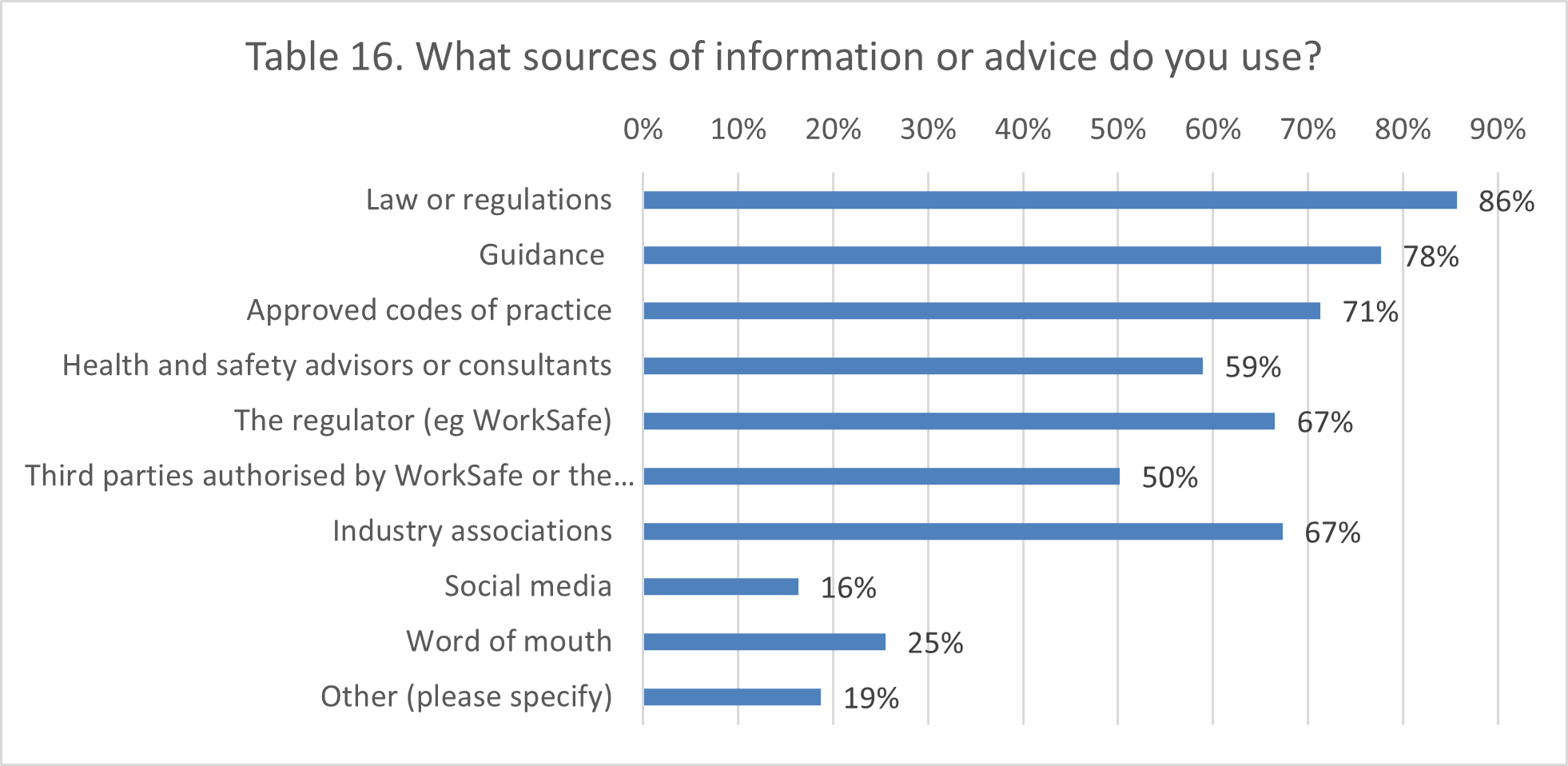
Data from chart
Table 17. The trend of submitter views across all sources of information and advice
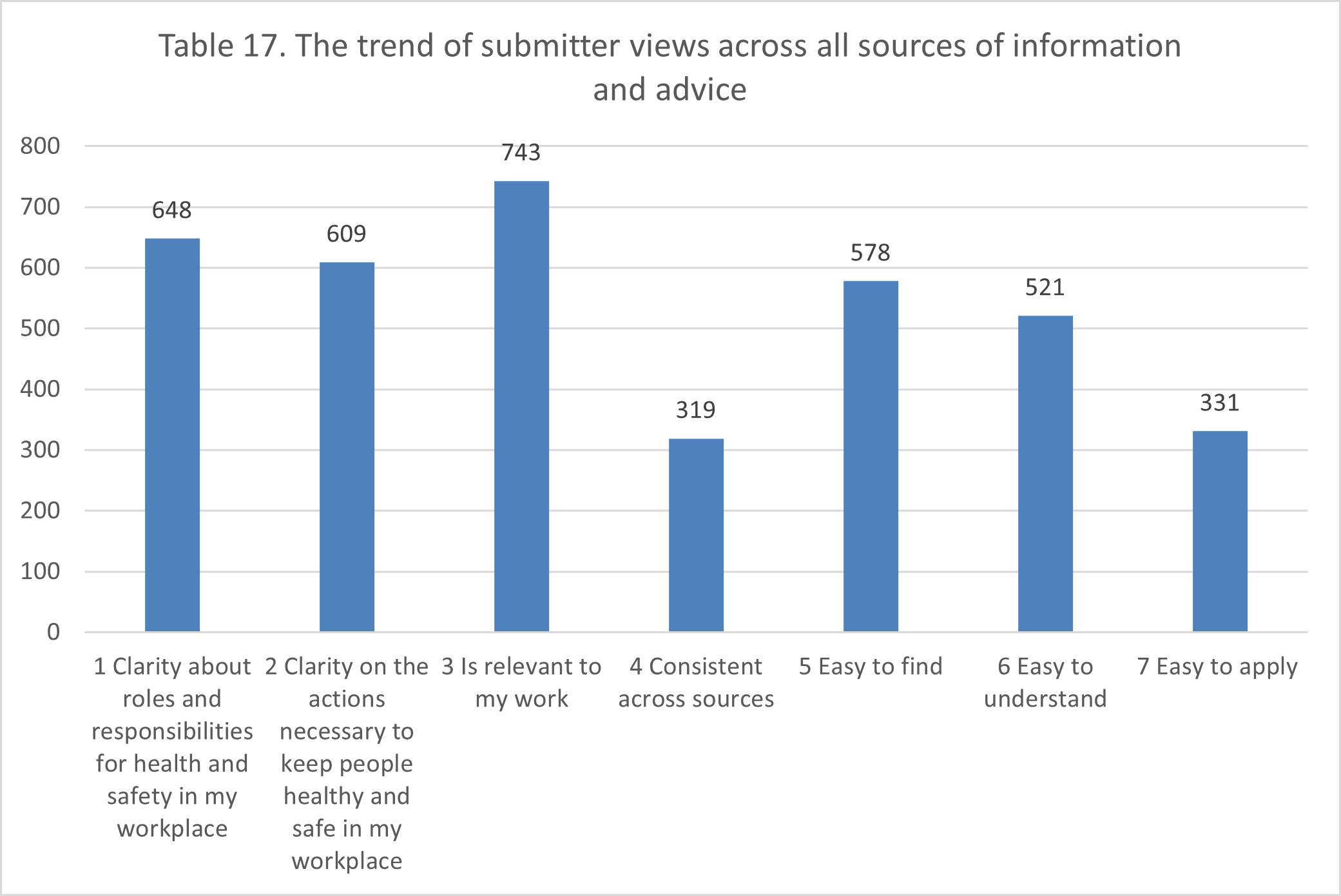
Data from chart
Are you able to provide any examples of where you have had difficulties because of the overlap between work health and safety legislation and other requirements?
Of the 141 respondents that provided examples of difficulties between overlapping legislation and other requirements:
- Some noted that were no issues with overlap, or specified overlaps with the Hazardous Substances and New Organisms Act 1996 (regulated by the Environmental Protection Agency), the Building Act 2004, Land Transport Act 1998, or other.
- Few noted overlaps with legislation governing the Primary Industries, Biosecurity and Environmental legislation, Energy (electricity and gas) safety, employment relations and employment standards legislation and systems, and Maritime and Civil Aviation rules.

